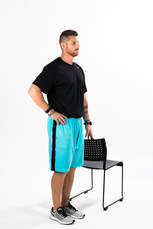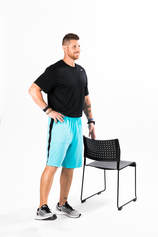One observation that I have made during this time of quarantine about my senior clientele and the internet, they have many questions about all the phases that exist of accessing the internet. They are certainly not dumb! I don’t think anyone believes that. However, I do believe that a lot of our Seniors feel as though there are too many complicated steps to access their exercise and trainers online. Along with this belief, we must remember that our seniors did not grow up with text messaging, FaceTime and Xbox live. They grew up in a time where real, face to face contact was the main way of communicating or a phone call. If you’ve worked with Seniors, even if it's only a few clients, then you understand what I am saying. Let’s just say, I have clients I can text and clients I need to call! Honestly, I think our Seniors are on to something with the calls vs. texts, but that’s another subject for another time.
So how do we convince our Seniors to hop online (pun intended) and train with us via the internet? I have found that by breaking down the process into phases, and then further breaking the phases down into simple steps allows for thorough understanding while limiting frustrations. I have also discovered that when explaining virtual sessions in this particular blueprint, I inadvertently answer questions that a Senior may have, but doesn't necessarily want to ask for fear of feeling insecure and unknowledgeable. Remember, for a lot of our Seniors, many responsibilities have been taken, or redirected from them (I.e. driving, cooking, etc.) for a number of reasons. The last thing I want to do, is make someone feel as though this is one more thing they cannot do or understand. This is the blueprint, or process, that I follow and that has had success with my clients. The motivation to actually exercise, that’s up to you! Lastly, both parties need to be PATIENT! We all have loads of time right now, so lighten the mood, make a joke and relax. Remember, with every mistake made, you’re closer to the answer.
A few things to consider before you start...
- You want them to pick a place that provides enough lighting so you can be seen by your trainer or client. Typically, I like to use the natural light of the sun, so anywhere next to a window is great. It is a good idea to have the camera facing away from the window so you can avoid any wash out that will make you appear dark.
- Also, make sure you have plenty of room to move around and do the movements and exercises.
The Blueprint:
1. Power button: The computer has a power button. So does the platform you, as a trainer or Senior, choose to use for these virtual (online) sessions. ZOOM, Skype or FaceTime are great platforms and there are many more similar ones out there. I like to use ZOOM because they have a “free” option and it's super easy to access. Learn how to turn the “power” on to the app or platform first.
2. Access (this is the hardest step for most): There are a few steps we need to cover to access the session. Now, the app is on and we need to get into the “room” or session so that we can see our trainer or instructor.
- Room numbers/codes: Think of this as the address. This number or code is what we need to enter into the computer that will give us access to session.
- Video/Audio: Hopefully, the default (original) settings are still set and not much needs to be done other than adjusting the volume to suit our needs. There are many tools available to both the trainer and the client such as YouTube and Google that can help us troubleshoot any issues and provide videos of the solutions. Don’t hesitate to utilize one, or both for information.
3. You've got the lights, the camera and now the action: Now it's time to get moving! Make sure the camera is adjusted so that you can be seen and heard clearly.
Good luck! I hope that everyone is staying safe and healthy during these "quarantine days"!
You can find exercise videos and more information about Emeritus Health and Balance University at:
Website:
https://www.emeritushealthfitness.com/
YouTube:
https://www.youtube.com/channel/UCFZBCssysteSE_QDxsKa58w?view_as=subscriber
Facebook:
https://www.facebook.com/EmeritusHealthFitness/











